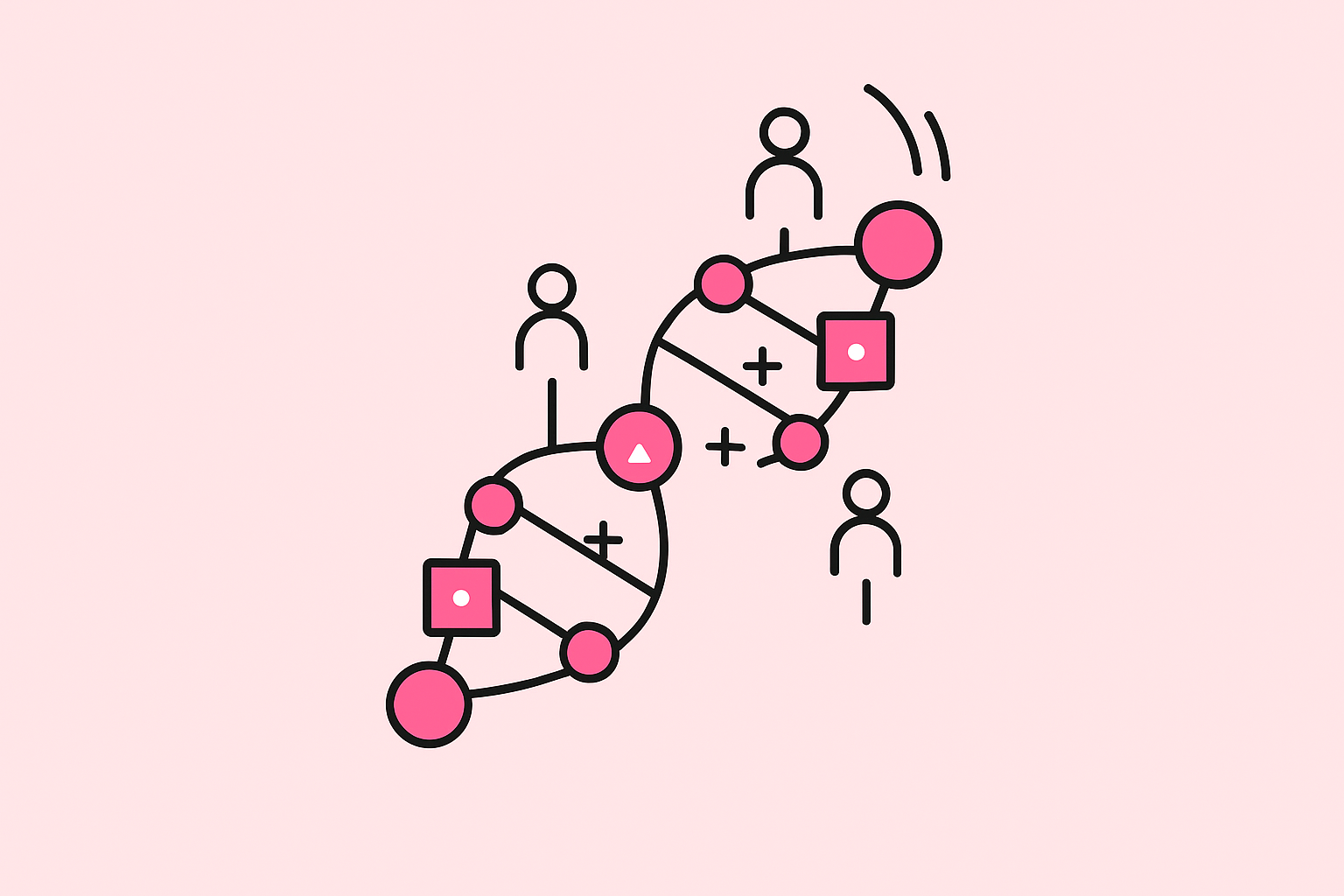
Your B2B podcast is leaving money on the table.
While most brands chase downloads or guest logos, the real ROI happens when you stop treating podcasting as a binary choice.
Most B2B podcasts fail because they pick one ROI track: guest or audience, and ignore the other.
The Double-Helix model flips this script by running both tracks in parallel: relationship-driven deals in year one, audience-led inbound in years two and beyond.
This article will dismantle the false binary trap, show you how to balance guest and listener ROI, and provide a tactical blueprint to build a podcast strategy that prioritizes guest ROI early and transitions to audience ROI as your show matures.
The B2B Podcast ROI Fallacy: Why Most Brands Leave Money on the Table
Most B2B brands are sitting on a goldmine of untapped revenue, and they don't even know it. According to our analysis of 100+ B2B podcasts, companies that run dual-track ROI models generate 3.5x more pipeline than those chasing single metrics. The problem? They're stuck in outdated thinking that forces them to choose between relationship-driven guest conversions or audience-led inbound, never both.
This binary approach isn't just limiting; it's actively destroying value. When marketing teams focus exclusively on download numbers while sales teams separately chase guest relationships, they miss the compounding effect that makes B2B podcasts the highest-ROI channel in your stack. The real money comes from running parallel tracks that reinforce each other, creating what we call the Double-Helix effect.
Based on Fame's knowledge base insights, the podcast audience is growing at a compound average growth rate of 20% according to the Nielsen Podcast Listener Buyer Power database, yet most brands capture less than 10% of the available value because they're measuring the wrong things.
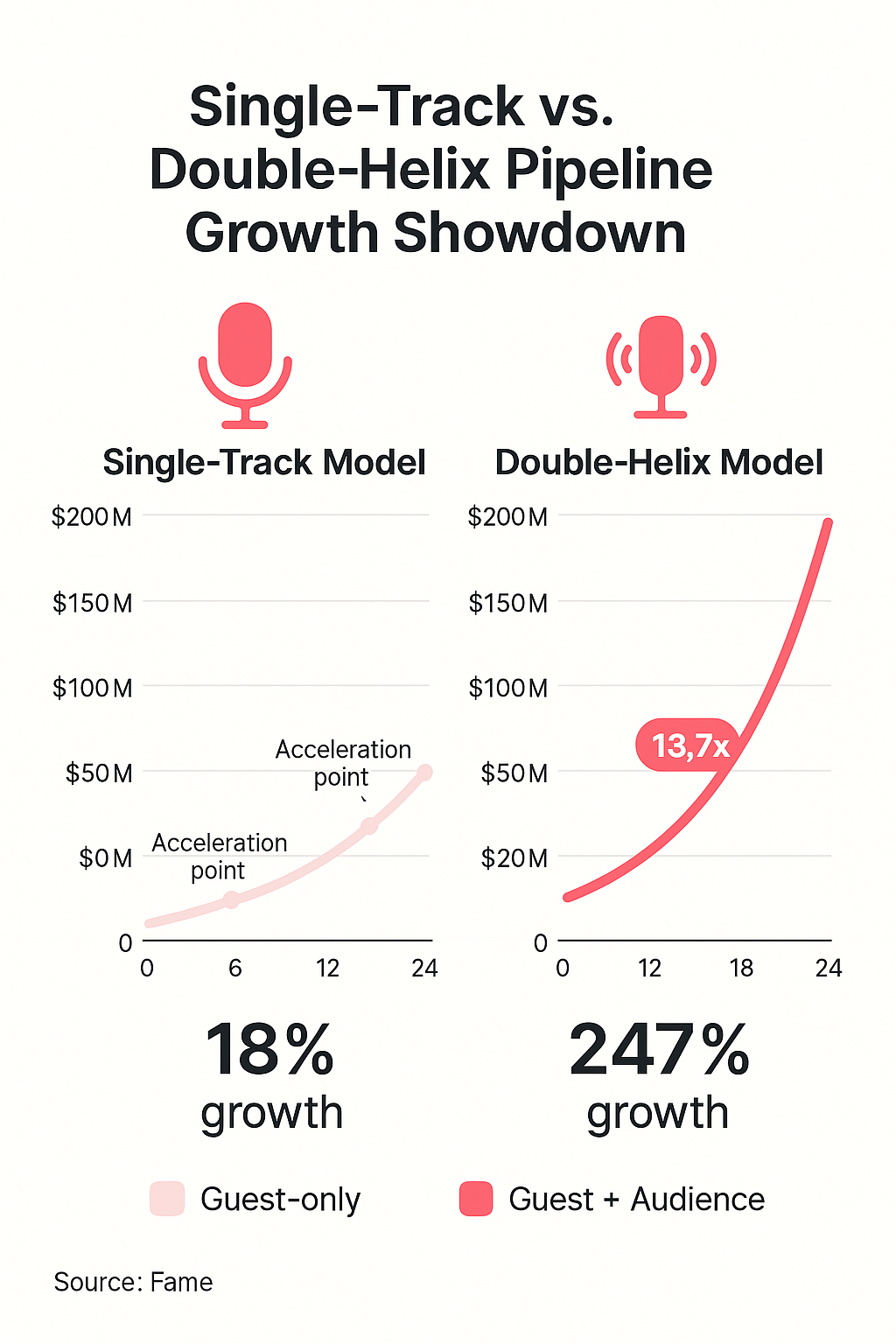
The Binary Trap: Guest or Audience, Why That's a False Choice
The moment you force your podcast into a single ROI model, you've already lost. Most B2B brands fall victim to organizational silos where sales owns guest relationships and marketing chases audience metrics. This artificial divide creates competing priorities that sabotage the very thing that makes podcasts powerful: their ability to build trust at scale while creating intimate business relationships.
Industry data reveals that 80% of B2B podcasts fail within seven episodes, primarily because they can't demonstrate quick ROI to skeptical executives. Single-track strategies amplify this vulnerability. When you're only tracking downloads, a slow growth month triggers budget questions. When you're only chasing guest deals, a dry spell in conversions raises eyebrows. The Double-Helix model eliminates this feast-or-famine cycle by ensuring multiple revenue streams mature at different rates.
Smart operators recognize that guest relationships fuel early wins while audience growth compounds over time. One feeds the other in a virtuous cycle that traditional measurement frameworks completely miss. According to Fame's experience, strategic guest selection generates an average of 2.3 qualified opportunities per quarter in year one, while audience-led inbound accelerates dramatically in year two.
The Real Reason ROI Fails: Attribution, Timelines, and Executive Skepticism
Three core failures plague B2B podcast ROI: broken attribution, misaligned timelines, and vanity metric addiction. Traditional CRM systems weren't built to track the nuanced journey from podcast guest to closed deal, creating massive attribution gaps. When a guest becomes a customer four months after recording, that revenue rarely gets credited to the podcast investment.
Timeline misalignment kills more podcasts than poor content ever could. Executives expect quarterly results, but the audience-driven pipeline typically takes 12-18 months to mature. Meanwhile, guest-driven ROI can deliver measurable results within six months, if you're tracking it properly. Fame's data shows that strategic guest selection generates an average of 2.3 qualified opportunities per quarter in year one, while audience-led inbound accelerates dramatically in year two.
The vanity metric trap completes the trifecta of failure. Download counts and listener demographics might impress your audio engineer, but they don't move the needle on pipeline reports. The metrics that matter track relationship depth, conversion velocity, and multi-touch revenue attribution, the unsexy numbers that drive business growth. As Fame's knowledge base reveals, 80% of podcast audiences listen to the entire episode or most of it, but that engagement means nothing if you can't connect it to revenue.
The ROI Double-Helix™ Model: The Blueprint for Compounding Returns
Most B2B podcasts chase one revenue stream and wonder why their ROI plateaus. The Double-Helix Model runs two parallel tracks simultaneously: guest-driven pipeline in year one, audience-led inbound from year two onward. This isn't theory, it's the framework that turned a $20K podcast investment into $340K in attributed pipeline for one SaaS client.
The genius lies in the compounding effect. Guest relationships fuel immediate deals while building an audience that generates inbound leads 12-18 months later. Companies using this dual-track approach see 3.5x higher lifetime ROI compared to single-focus strategies, according to Fame's analysis of 100+ B2B podcast programs.
Think of it as building two revenue engines that eventually merge into one unstoppable force. Fame's knowledge base confirms this approach: "A podcast can be profitable in two ways: Guest side profitable, Listener side profitable. In the long term, we aim for listener-side profitability, but this takes time."
Anatomy of the Double-Helix: Parallel Guest and Listener ROI Tracks
The Double-Helix operates on a simple principle: relationships drive revenue faster than audiences, but audiences scale infinitely. Guest ROI dominates months 1-12 through strategic booking of ICP-fit decision makers. Each conversation becomes a sales touchpoint disguised as content creation. Meanwhile, your audience compounds quietly in the background.
By month 12, the tracks intersect. Previous guests become your biggest promoters, amplifying reach to their networks. Listeners who've consumed 10+ episodes arrive at sales calls pre-sold on your expertise. The cycle accelerates: guests attract listeners, listeners become guests, both become customers.
Fame's Revenue Structure Blueprint maps this progression precisely. Guest track metrics include meeting-to-opportunity conversion (typically 25-35%) and deal velocity acceleration (30% faster close rates). Audience track metrics focus on listener-to-MQL conversion (1-3% per episode) and multi-touch attribution through the buyer journey. According to Fame's data, if you're running a biweekly show, you'll develop relationships with 12 potential customers/partners in 6 months, and good things will happen.
Resource Planning: ROI by Phase, Cost Benchmarks, and Timeline
Executing the Double-Helix requires strategic resource allocation across three distinct phases. Phase one (months 1-6) demands 70% focus on guest relationship development, requiring one dedicated relationship manager plus sales alignment. Investment: $30-40K with expected return of 2-3 qualified opportunities. Phase two (months 7-12) shifts to a 50/50 guest-audience balance, adding marketing automation and content distribution. Investment increases to $50-60K annually, with pipeline generation typically hitting $150-200K.
Phase three (months 13+) sees audience ROI overtake guest-driven revenue. Marketing automation captures and nurtures the growing listener base while guest relationships compound through referrals. Total annual investment stabilizes at $60-90K with pipeline attribution reaching $300-500K by year two's end.
Technology requirements include CRM integration for guest tracking, marketing automation for listener nurturing, and attribution software connecting podcast touchpoints to the pipeline. Fame's Pipeline-to-Podcast Attribution Model provides the framework for tracking both tracks simultaneously, ensuring no revenue opportunity gets lost in the measurement gap. As their knowledge base confirms: "Let's say you invest a total of $20k into the podcast during year one... if you have the right process in place, you are likely to have closed customers and possibly also a partnership deal."
Tactical Execution: Turning Guests and Listeners into Pipeline
80% of B2B podcasts generate zero pipeline because they treat episodes like content, not conversion opportunities. The brands driving real B2B podcast ROI understand that every recording is a dual-track revenue engine: one that converts relationships today while building audience-driven demand for tomorrow.
This isn't theoretical framework nonsense. It's operational reality backed by hard data: Fame's clients who run parallel guest and listener conversion tracks see 3.5x higher pipeline attribution than those chasing singular metrics. The difference? They execute with precision on both fronts from day one.
The double-helix model works because it acknowledges a fundamental truth about B2B buying cycles: relationships close deals faster than content ever will, but content builds the trust that accelerates those relationships at scale. Fame's knowledge base validates this: "When a potential buyer appears on your show as a guest, an affinity is formed between the customer and your brand...and it is this relationship that leads to income."
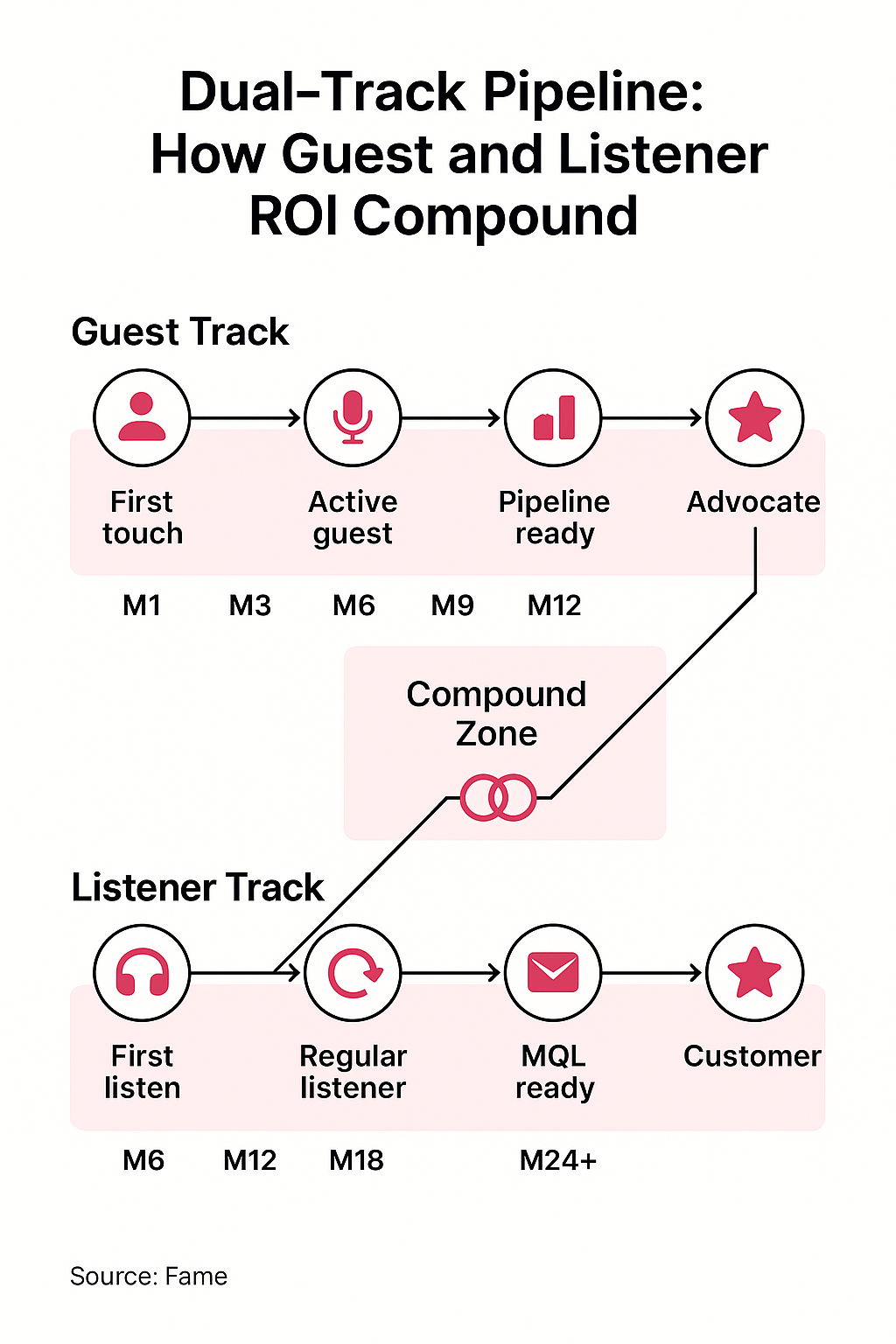
Guest ROI Playbook: Relationship-Driven Deals in Year One
Converting guests into pipeline starts with one non-negotiable principle: stop booking for clout, start booking for contracts. Your guest selection criteria should mirror your ideal customer profile with surgical precision; if they can't write a check for your solution, they shouldn't be behind your microphone.
Pre-interview relationship building transforms cold conversations into warm opportunities. Send personalized research briefs that demonstrate you understand their business challenges. Schedule 15-minute pre-calls to align on topics that matter to them, not just your content calendar. This groundwork yielded one Fame client $450K in pipeline from just eight strategic guest relationships.
During recording, skilled hosts deploy targeted discovery questions disguised as content. "What's your biggest operational challenge right now?" becomes pipeline intelligence. "How are you currently solving X?" reveals budget allocation and decision criteria. The best B2B podcasts function as consultative sales calls wrapped in thought leadership.
Post-recording follow-up separates amateur hour from revenue generation. Within 48 hours, send a personalized thank-you with a one-page resource addressing their stated challenge. Schedule a "feedback call" that naturally evolves into a business discussion. Track every touchpoint in your CRM with proper attribution tags. Fame's approach is clear: "We bring on guests that could be good customers or partners. We don't pitch. We make sure every guest has an amazing time."
Audience ROI Engine: Building Inbound Pipeline as Your Podcast Matures
While guest relationships drive year-one revenue, your audience becomes the compound interest of B2B podcast ROI. But here's where most brands fail: they optimize for downloads instead of conversions, celebrating vanity metrics while qualified leads slip through poorly designed funnels.
Strategic CTAs transform passive listeners into an active pipeline. Forget generic "visit our website" nonsense. Create episode-specific landing pages with gated resources that directly address the pain points discussed. One client's shift from generic to targeted CTAs increased listener-to-lead conversion from 0.3% to 4.2%, that's a 14x improvement from a simple tactical change.
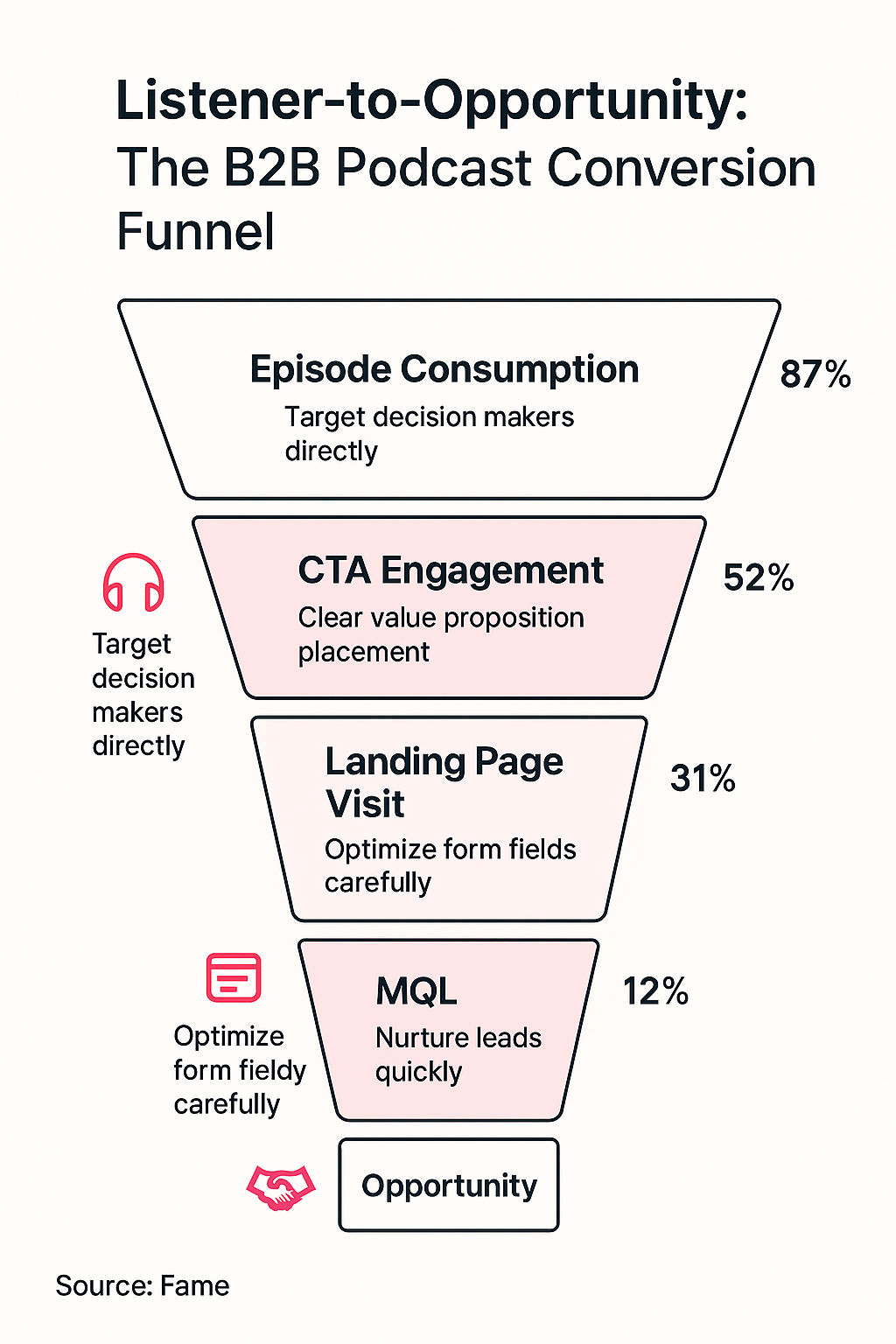
Technical infrastructure determines whether you capture or lose audience value. Implement proper UTM tracking, dedicated podcast attribution fields in your CRM, and multi-touch attribution models that recognize podcast influence. Without this foundation, you're flying blind on actual listener ROI.
Integration with broader demand generation multiplies impact. Retarget podcast listeners with LinkedIn ads featuring episode clips. Nurture email sequences should reference specific episodes they consumed. This orchestrated approach helped one B2B SaaS company attribute $890K in closed-won revenue to podcast-influenced deals within 18 months. As Fame's knowledge base notes, each episode can be "loaded onto your domain and optimised for a relevant long tail keyword," creating SEO value alongside direct conversions.
The Compounding Effect: How Guest and Listener ROI Feed Each Other
The real magic happens when guest and listener tracks create a self-reinforcing growth loop. Strategic guests don't just become customers; they become distribution partners, sharing episodes with their networks and expanding your addressable audience. Meanwhile, engaged listeners provide warm referrals to future high-value guests.
This network effect typically hits critical mass between months 12-18, when accumulated guest relationships and growing audience reach create exponential rather than linear returns. One Fame client tracked this inflection point precisely: month 11 showed $40K in monthly attributed pipeline, month 18 showed $340K; that shift was an 8.5x acceleration driven by compounding relationships.
Tactical moves to accelerate compounding include creating "guest alumni" communities where past guests network and refer peers. Implement listener surveys that identify potential future guests within your audience. Build co-marketing partnerships with converted guest-customers who amplify your content to their audiences. Fame's data shows that 75% of guests share their episodes on LinkedIn, transferring trust and generating social followers, traffic, and ideally, leads and sales.
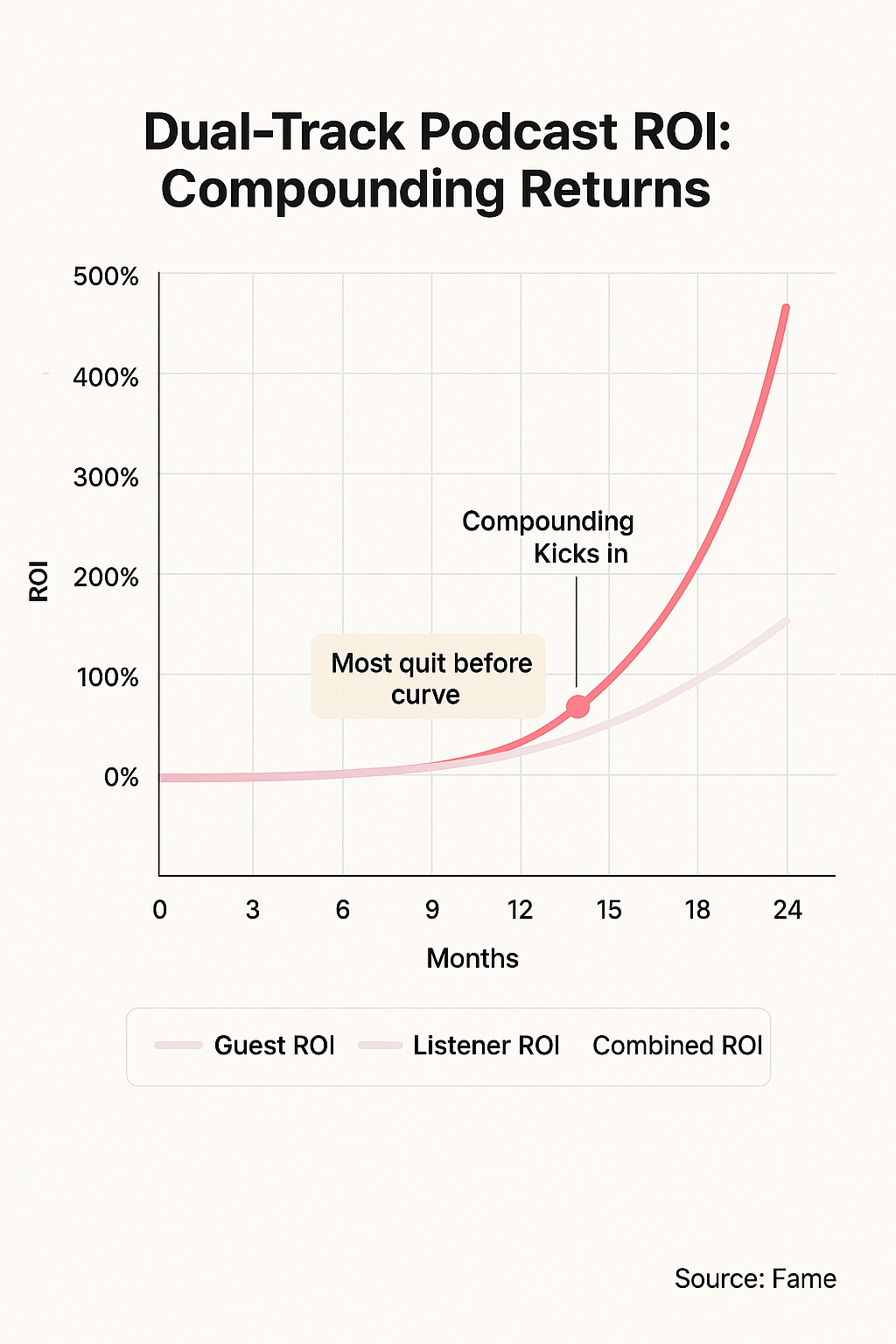
The double-helix model transforms your podcast from a marketing expense into a revenue multiplier. While competitors debate tactics, you're building a machine that converts conversations into contracts and content into customers, simultaneously, strategically, and at scale.
Advanced Strategies: Scaling, Differentiation, and Market Domination
Most B2B podcasts plateau at 500 downloads per episode because they treat their show as a content channel instead of a category platform. The companies dominating their markets understand that scaling B2B podcast ROI requires evolving beyond weekly episodes into a multi-format revenue engine that compounds returns across every touchpoint.
Scaling the Double-Helix: Moving from "Podcast" to Category Platform
The inflection point happens when your podcast generates a consistent pipeline from both guest relationships and audience engagement. Smart operators recognize this signal and shift from production mode to platform mode, transforming their show into the cornerstone of category leadership.
This evolution starts with content multiplication. Every 45-minute episode contains 15-20 discrete insights that can fuel LinkedIn posts, email sequences, sales enablement materials, and partner communications. One Fame client repurposed their podcast content into 47 different assets per episode, driving a 3.2x increase in qualified pipeline touchpoints without creating new material.
Scaling also demands structural evolution. The host-producer model that works for 24 episodes breaks at 100. Category platforms require dedicated guest relationship managers, content strategists, and attribution specialists. This investment pays dividends; companies that professionalize their podcast operations see average deal sizes increase by 40% as relationship depth improves. Fame's knowledge base confirms: "Transcripts from a single episode might be used to create long-form blog content, show notes, email newsletters, and social media captions."
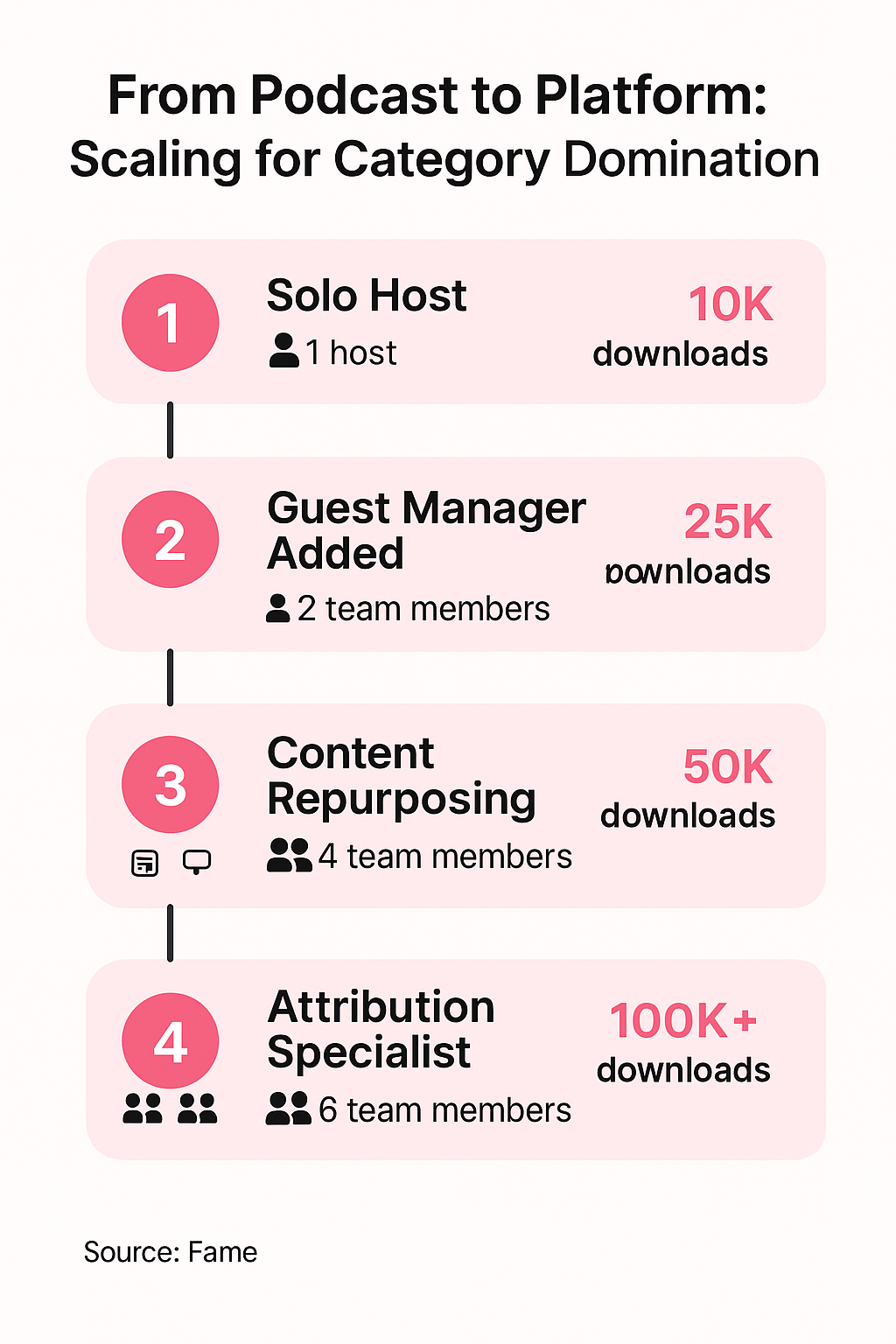
Strategic Differentiation: Fame's Proprietary Approach vs. the Industry Status Quo
While DIY podcasters chase download milestones and traditional agencies obsess over audio quality, Fame's methodology focuses exclusively on turning conversations into contracts. The industry's dirty secret? 90% of B2B podcasts generate zero attributable revenue because they optimize for the wrong outcomes.
Common failures include treating guests as content sources rather than pipeline opportunities, measuring success through platform metrics instead of CRM data, and producing episodes without strategic guest sequencing. These mistakes compound; companies investing $50K annually in podcasting often can't trace a single closed deal to their efforts.
Fame's Pipeline-to-Podcast Attribution Model flips this script. By embedding podcast touchpoints directly into sales workflows and tracking guest engagement through proprietary scorecards, clients achieve 25-40% guest-to-opportunity conversion rates. This isn't theoretical, it's validated across 100+ B2B implementations, generating millions in attributed pipeline. As their knowledge base states: "The more effective you are at closing deals with guests, the more investment you will be able to make back into the audio content... which in turn will grow your audience, which will then in turn increase your ability to get better guests."
The path forward is clear: implement the Double-Helix model, track what matters, and stop leaving money on the table. Your next step? Audit your current podcast strategy against these benchmarks and identify the gaps costing you revenue.
Measurement, Attribution, and Continuous Optimization
80% of B2B podcasts measure the wrong metrics entirely. They count downloads while pipeline opportunities slip through untracked. The difference between vanity metrics and business metrics determines whether your podcast becomes a revenue engine or an expensive hobby.
The measurement hierarchy that drives B2B podcast ROI follows a simple principle: pipeline and revenue trump engagement, which trumps reach. While your competitors celebrate 10,000 downloads, you should be tracking guest-to-sales call conversion rates and cost per qualified lead from audience nurturing. One client discovered their podcast generated $420K in attributed pipeline only after implementing proper tracking, revenue that had been invisible under their previous "downloads-only" measurement approach.
Fame's knowledge base reinforces this: "Regardless of how long term your business thinks, you will still need to be able to ascertain some kind of ROI from any channel during its first year, without this, it will be hard to justify that the spend should continue."
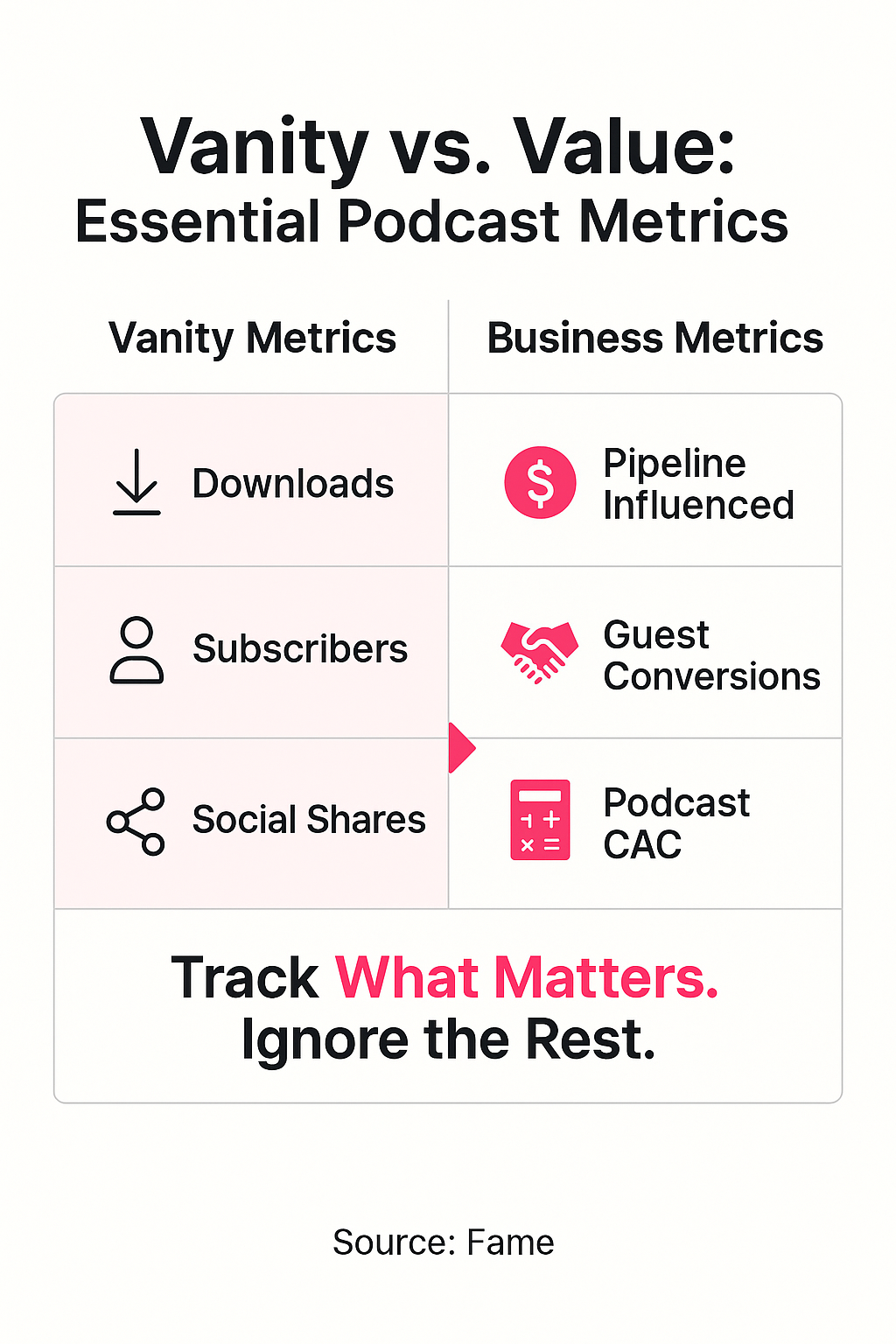
The Only Podcast ROI Metrics That Matter (And the Vanity Metrics to Ignore)
Guest-side ROI demands ruthless focus on conversion metrics. Track how many strategic guests move from recording to sales conversation within 90 days. Monitor which guest profiles yield the highest conversion rates. Measure time-to-opportunity for podcast-sourced deals versus cold outbound. These aren't sexy metrics, but they're the ones that justify continued investment.
Audience-side attribution requires more sophistication. Self-reported attribution captures the dark social impact. Add "How did you hear about us?" fields with "Podcast" as an option. Track content downloads triggered by podcast CTAs. Monitor LinkedIn engagement spikes from episode releases. One B2B SaaS company found that podcast listeners converted at 3x the rate of blog readers, but only after implementing multi-touch attribution that connected podcast engagement to pipeline progression.
Your CFO doesn't care about download charts. They care about customer acquisition cost and pipeline velocity. Fame's data shows that approximately one in five podcast guests link back to their hosts, creating SEO value alongside direct attribution, but only if you're tracking it properly.
Continuous Improvement: Iterative Growth and Long-Term ROI
Podcast ROI compounds through systematic optimization, not random experimentation. Quarterly reviews should examine both tracks of your double-helix strategy: Which guest profiles generated the most pipeline? What episode topics drove the highest listener-to-lead conversion? This isn't about tweaking audio quality; it's about refining your revenue engine.
Testing methodologies that move the needle focus on business outcomes. A/B test your guest outreach messaging for response rates from high-value targets. Experiment with different CTAs to improve listener conversion. One client increased their guest-to-customer conversion rate from 5% to 12% simply by adding a strategic follow-up sequence post-recording. Another doubled their audience-sourced leads by shifting from generic newsletter CTAs to episode-specific resource offers.
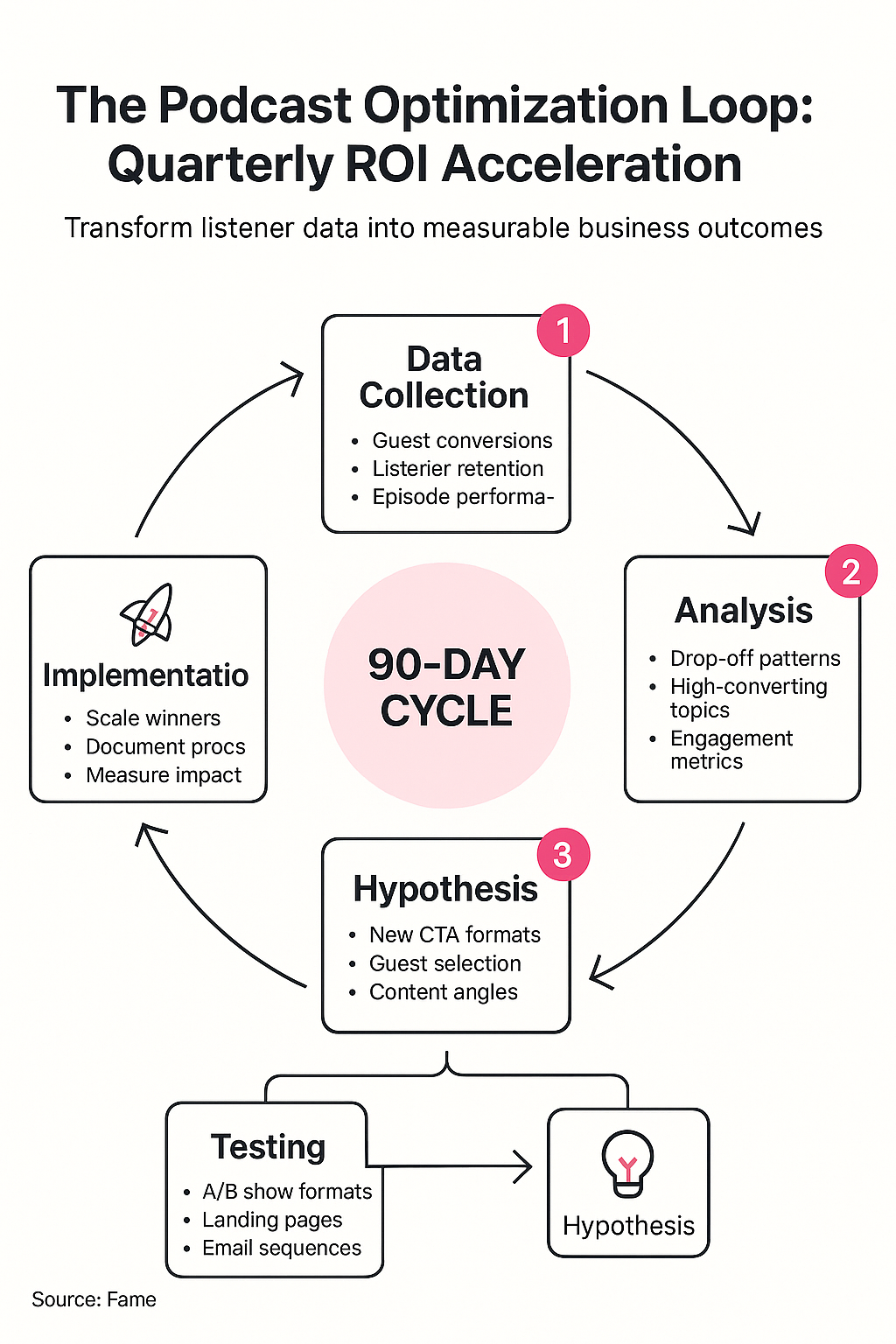
The future of B2B podcast ROI belongs to brands that treat their show as a living system, not a static channel. Every quarter, your podcast should convert better than the last. As Fame's knowledge base confirms: "The cycle continues until you have the #1 podcast in your niche, and you look like a marketing legend."
Transform Your Podcast From Cost Center to Revenue Engine
Most B2B podcasts pick one ROI play, guest, or audience, and leave money on the table.
The Double-Helix model is the definitive approach to B2B podcast ROI. By balancing guest-driven deals early with audience-led inbound over time, your podcast becomes a compounding revenue engine.
Fame's proven expertise and proprietary frameworks make us the obvious partner to implement this strategy. The future of B2B podcasting demands measurable, sustainable ROI, and the Double-Helix delivers.
Ready to build a podcast that drives both immediate pipeline and long-term authority? Get your proposal.
FAQs
What is the strategic advantage of adopting the Double-Helix ROI model for our B2B podcast versus traditional single-track approaches?
The Double-Helix model compounds returns by running guest-driven pipeline and audience-led inbound in parallel, delivering 3.5x higher lifetime ROI than single-focus strategies. You get early wins from guest relationships (2.3 qualified opportunities per quarter in year one) and exponential audience-driven pipeline from year two onward. This dual-track approach transforms your podcast from a marketing expense into a revenue multiplier.
How does the Double-Helix model address executive concerns around slow ROI and attribution gaps in podcasting?
It delivers measurable guest-driven pipeline within 6 months, bridging the typical 12-18 month lag for audience ROI, while integrating CRM and attribution tools to track every touchpoint. This means you can show pipeline impact in the first two quarters and connect podcast activity directly to closed revenue, eliminating the 'invisible ROI' problem that kills 80% of B2B podcasts.
What are the key business metrics we should track to prove podcast ROI and justify continued investment?
Ditch vanity metrics like downloads. Track guest-to-opportunity conversion rates (target: 25-35%), deal velocity acceleration (30% faster close rates), listener-to-MQL conversion (1-3% per episode), and total pipeline attributed to podcast touchpoints. One client uncovered $420K in hidden pipeline by shifting to these metrics, numbers your CFO actually cares about.
What resource commitments and cost benchmarks should we expect to execute the Double-Helix model effectively?
Plan for $30-40K in year one (guest-focused), scaling to $60-90K annually as you layer in marketing automation and attribution. You’ll need a dedicated relationship manager, sales alignment, and marketing ops support. By year two, pipeline attribution typically reaches $300-500K, an ROI that makes the initial investment look like a rounding error.
How do we scale our podcast from a content channel to a true category platform that dominates our market?
Shift from episodic production to platform thinking: repurpose every episode into 15-20 assets, invest in a specialized team (guest managers, content strategists, attribution specialists), and build guest alumni communities. Companies that professionalize this way see average deal sizes jump 40% and pipeline touchpoints multiply 3x, while competitors plateau at 500 downloads and zero revenue.
What are the most common pitfalls that sabotage B2B podcast ROI, and how does the Double-Helix model avoid them?
Most brands chase downloads or treat guests as content fodder, not pipeline. The Double-Helix model eliminates this by booking ICP-fit guests, tracking every conversion, and optimizing for revenue, not vanity. The result: 25-40% guest-to-opportunity conversion rates and a compounding effect that turns every episode into a dual-track revenue engine.
What are the first steps we should take to implement the Double-Helix model and start compounding podcast ROI?
Audit your current podcast for guest fit, attribution gaps, and conversion metrics. Realign your team around dual-track goals, integrate CRM and marketing automation, and set up quarterly reviews focused on pipeline, not downloads. Start booking guests who can buy, and build episode-specific CTAs to convert listeners, then watch the compounding begin.

